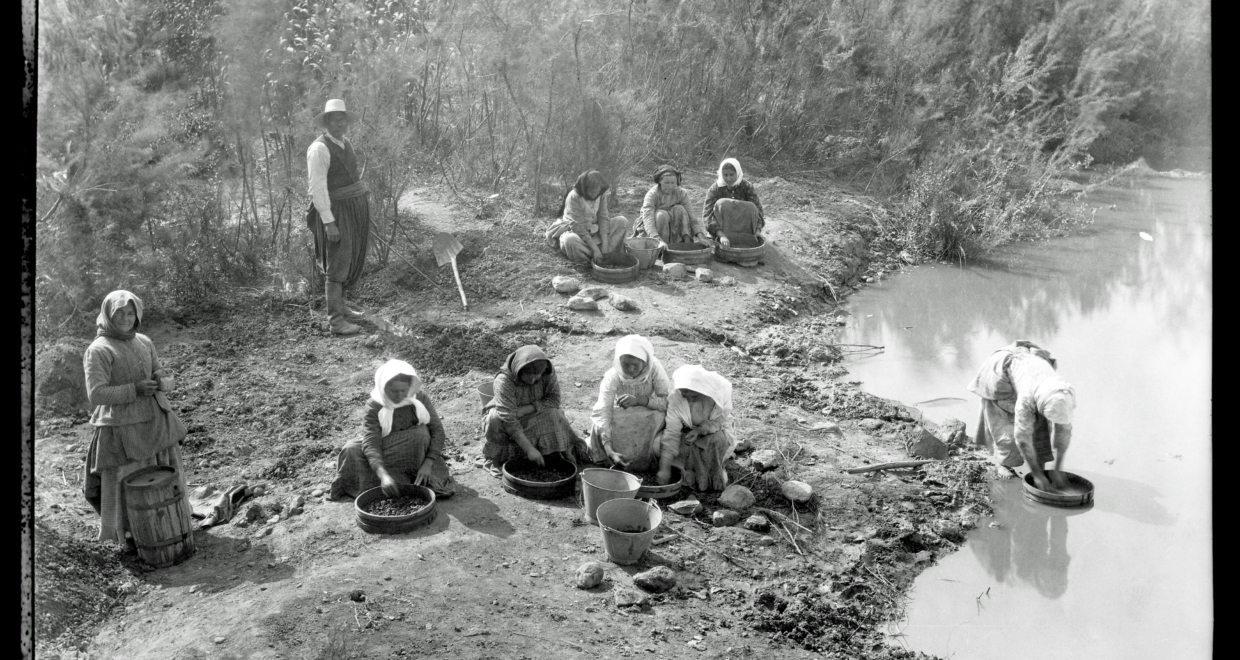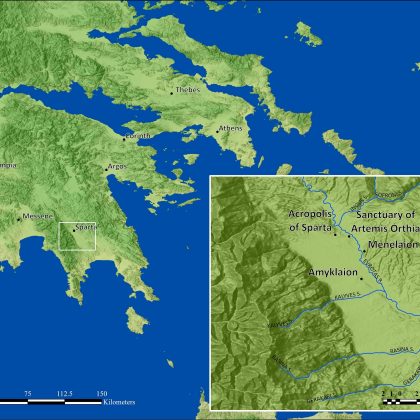A History of Archaeology at Sparta
The Annual of the British School at Athens (ABSA) has long been a preferred repository of research on Sparta. This introduction provides a brief history of research in the region and an account of further developments in archaeological and historical research. British work in Sparta and Laconia began with topographic study in 1904. Since then, the School has conducted several excavations and surveys at the Spartan acropolis (1906-10, 1924-28, 1988-91, 1992-98, 2000, 2008) and other programmes of work in the wider region, such as the Laconia Survey from 1983-1989 (W.G. Cavanagh et al., The Laconia Survey [BSA Supp. Vols. 26-7, London 1996-2002]) and the excavation of the Menelaion, an important Bronze Age site and later Classical sanctuary (see thus far H.W. Catling. [ed.]. Menelaion I: The Bronze Age [BSA Supp. Vol. 45, London, 2009]). The publications of ABSA reflect the full breadth of work which can be conducted on Sparta and Laconia, covering archaeological fieldwork, the interpretation of its results, and broader interpretative pieces on the history and culture of ancient Sparta.
Image credit: Sparta, Artemis Orthia: women washing [soil, from artefacts, in the Eurotas River], ca. 1907. BSA SPHS 01/5027.7826, BSA SPHS Image Collection, BSA Archive.
Excavation work began at Sparta in 1906 which concentrated on the acropolis and the west bank of the Eurotas, which uncovered the sanctuary of (Artemis) Orthia and a number of other important sites (ABSA 12, 277-479). Topographic study of the region, such as Foster and Woodward’s fascinating study of the topography and archaeology of the Mani Peninsula (ABSA 13, 219-267), was also conducted. As part of the same programme of work a catalogue of the Sparta Museum was produced by Alan Wace and Marcus Tod (A Catalogue of the Sparta Museum [Oxford, 1906]). The resumption of work from 1924 to 1928 at Sparta under the direction of Wace, who had been a member of the original excavation team, focused on further study of the Spartan acropolis and a more detailed investigation of the Roman Theatre constructed on the western side of the acropolis hill (ABSA 26, 116-310).
Subsequent fieldwork by the BSA has focused on investigation of the Roman and Byzantine phases of the acropolis hill. Excavations directed by Waywell and Wilkes investigated a couple of Late Roman structures on the hill, especially the Roman Stoa (ABSA 89, 377-432) and the Theatre. These excavations permitted a detailed reconstruction of the theatre from its initial construction in the Augustan period to its later remodelling and occupation, perhaps c.78 AD; the theatre is an especially well-preserved example of a Late Roman skenotheke, a storage area within the stage-building which allowed scenery to be moved onto the stage area on rollers (ABSA 94, 437-455).
The second important strand of this new programme of research was serious study of the Byzantine settlement which later occupied the acropolis hill, with the later excavations at the theatre investigating aspects of the settlement in the area of the cavea and orchestra. Of particular note is Sanders’ work on the medieval pottery from Roman Stoa remains essential both for the understanding of medieval fine wares (e.g. Zeuxippos ware) and medieval coarse wares (ABSA 88, 251-286). The Acropolis Basilica Project undertook cleaning and architectural study of the hill’s basilica of Agios Nikon, alongside the archival study of previous excavations (ABSA 97, 429-468). The recent publication of a 2008 excavation has added significantly to the understanding of Byzantine Sparta, including preliminary bioarchaeological analyses of Byzantine-era tombs and the of post-antique pottery from the settlement (ABSA 119, 483-564).
Aside from fieldwork, ABSA has published archaeological studies which have defined various fields of Laconian archaeology, with a particular emphasis on ceramic studies. The earliest such piece is Lane’s study of Laconian vase painting, the first major attempt after Droop’s initial studies to systematise, classify, and understand Laconian black-figure pottery (ABSA 34, 99-189). Coulson’s publication of Protogeometric pottery from Sparta performed a similar role, even if many his conclusions are no longer accepted (ABSA 80, 29-84). Boardman’s short but influential article on Laconian chronology revisited some key conclusions of the early British excavations (ABSA 58, 1-7). Focusing on metal rather than ceramic material, Cavanagh and Laxton published an important seriation study of lead figurines from the Menelaion, an important class of votive distinct to Laconia (ABSA 79, 23-36). Small finds are also the subject of Villing’s interesting study of a particular votive category, namely bronze and terracotta bells, which also seeks to place Spartan votive behaviour in a wider Greek context (ABSA 97, 223-295).
Epigraphic studies have also formed an important element of ABSA’s Spartan output. The early British excavations uncovered roughly 200 new inscriptions, the discovery of which fed into the publication of the IG volume for Laconia and Messenia (W. Kolbe [ed.]. Inscriptiones Graecae V.1: Inscriptiones Laconiae et Messeniae [Berlin, 1913]), which remains the standard collection of inscriptions from these regions. Hondius and Woodward’s study of dedicatory inscriptions from the 1906-10 excavations still represents an important resource for scholars (ABSA 24, 88-143). Since this early work, Spawforth’s studies on the Roman epigraphy and prosopography of Sparta have been especially fruitful, such as his article on the connections between Herodes Atticus’ family and Roman Sparta (ABSA 75, 203-220).
Several historical and archaeological studies have explored the relationship between Sparta and its wider territory. Shipley explores the quite drastic changes in the extent of Spartan territory following the Lakedaimonians defeat at the Battle of Leuktra in 371 BC (ABSA 95, 367-390). The study of sacred sites has been particularly important for understanding connections between Sparta and its wider region. Koursoumis’ collects the existing evidence and re-examines several in situ inscriptions relating to the sanctuary of Artemis Limnatis, situated in the Ager Denthealiatis,which constituted a formal boundary between Laconia and Messenia in the Roman period and was likely an important regional sanctuary in centuries prior (ABSA 109, 191-222). Pavlides examines two sanctuaries in eastern Laconia, Apollo Tyritas and Apollo Maleatas, to explore the concrete links that such sites provided between Sparta and its perioikoi, ‘dwellers around’ (ABSA 113, 279-305). In the same volume, Christesen attempts to understand diachronic changes in the patterns of burials in Sparta placing them in their social and historical context (ABSA 113, 307-363). Excavation work in Laconia has also discovered sites which were previously unknown from literary or epigraphic material, such as the 1989 rescue excavation of the Archaic sanctuary of Zeus Messapeus near Aphysou in the Eurotas Valley (ABSA 85, 15-35).
Thomas Clements (Center for Hellenic Studies, Harvard University)
Fieldwork
R.C. Bosanquet et al., ‘Laconia II. Excavations at Sparta, 1906’, ABSA 12 (1905/6), 277-479.
E.S. Forster and A.M. Woodward, ‘Laconia II. Topography’, ABSA 13 (1906/7), 219-267
A.M. Woodward and M.B. Hobling, ‘Excavations at Sparta, 1924-25’, ABSA 26 (1923/4-1924/5), 116-310.
H.W. Catling, ‘A sanctuary of Zeus Messapeus: excavations at Aphysou, Tsakona, 1989’, ABSA 85 (1990), 15-35.
G.B. Waywell and J.J. Wilkes, ‘Excavations at Sparta, 1988-91: The Roman stoa’, ABSA 89 (1994), 377-432.
G.B. Waywell and J.J. Wilkes, ‘Excavations at the ancient theatre of Sparta, 1995-98’, ABSA 94 (1999), 437-455.
R. Sweetman and E. Katsara, ‘The Acropolis Basilica Project, Sparta: a preliminary report for the 2000 season’, ABSA 97 (2002), 429-468.
A. Vasilogamvrou et al., ‘Excavations at the ancient theatre of Sparta, 2008’, ABSA 119 (2024), 483-564.
Archaeological analyses
E.A. Lane, ‘Laconian Vase-painting’, ABSA 34 (1933/4), 99-189.
J. Boardman, ‘Artemis Orthia and chronology’, ABSA 58 (1963), 1-7.
W.G. Cavanagh and R. Laxton, ‘Lead figurines from the Menelaion and seriation’, ABSA 79 (1984), 23-36.
W.D.E. Coulson, ‘The Dark Age pottery of Sparta’, ABSA 80 (1985), 29-84.
G.D.R. Sanders, ‘Excavations at Sparta: the Roman stoa, 1988-91 preliminary report, part 1: (c) medieval pottery’, ABSA 88 (1993), 251-286.
A. Villing, ‘For whom did the bell toll in ancient Greece? Archaic and Classical Greek bells at Sparta and beyond’, ABSA 97 (2002), 223-295.
Epigraphy
J.J.E. Hondius and A.M. Woodward, ‘Laconia I. Inscriptions’, ABSA 24 (Supplement 1919/20-1920/21), 88-143.
A.J.S. Spawforth, ‘Sparta and the family of Herodes Atticus: a reconsideration of the evidence’, ABSA 75 (1980), 203-220.
Historical and material studies
G. Shipley, ‘The extent of Spartan territory in the Late Classical and Hellenistic periods’, ABSA 95 (2000), 367-390.
S. Koursoumis, ‘Revisiting Mount Taygetos: the sanctuary of Artemis Limnatis’, ABSA 109 (2014), 191-222.
N.A. Pavlides, ‘The sanctuaries of Apollo Maleatas and Apollo Tyritas in Laconia: religion in Spartan-perioikic relations’, ABSA 113 (2018), 279-305.
P. Christesen, ‘The typology and topography of Spartan burials from the Protogeometric to the Hellenistic period: rethinking Spartan exceptionalism and the ostensible cessation of adult intramural burials in the Greek world’, ABSA 113 (2018), 307-363.
You can find ABSA‘s Sparta Bundle here.






